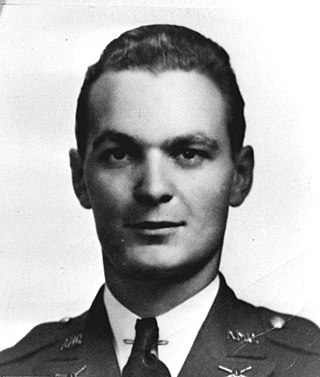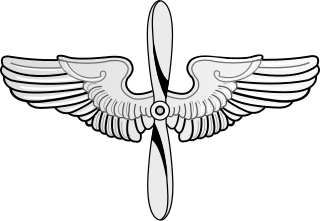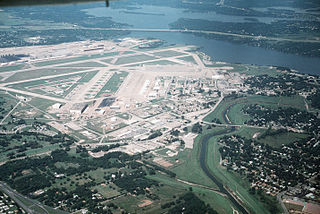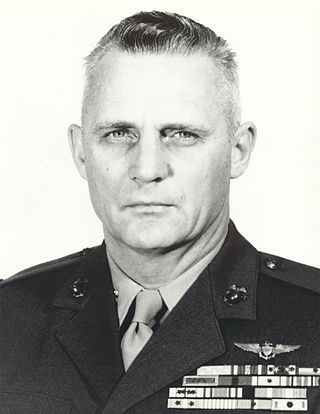Alan C. Carey | |
|---|---|
| Born | Orange County, California |
| Occupation | Author, historian |
| Period | 1999-present |
| Genre | Military History |
| Notable works | We Flew Alone, 2nd Ed. Twin Mustang: The North American F-82 at War |
Alan C. Carey is an American author and historian who specializes in military aviation topics.
Carey was born in Orange County, California to Robert Watson Carey (1926-2004) and Joyce Kathleen Haynes (1928-1991). He holds dual citizenship with the United States and Great Britain. Carey is a graduate of Southwest Texas State University (now Texas State University) with a master's degree in public administration and a bachelor's degree in history and political science.
Carey was born while his father was stationed at Marine Corps Air Station El Toro. His father served as an aviation radioman, air gunner, and navigator serving from World War II to the Vietnam War. Carey's childhood as a military dependent consisted of living in three states and three foreign countries before the age of five. His father's retirement and subsequent second career in the construction industry resulted in the family moving to several more states before settling in Texas in 1975. His writing career began as an intern with the Texas State Historical Commission in 1992 where he co-authored Historic Preservation Easements in Texas.
Like his father, a veteran of the Navy and Marine Corps, Carey enlisted in the military serving in the U.S. Marine Corps as a machine gunner/team leader and in the U.S. Army Reserve as a nuclear, biological, and chemical defense specialist and weapons instructor.
Carey's early interest in military aviation history stems from his father's career as an aviation radioman and air gunner with Navy Bombing Squadron 109 (VB-109) and reading the works of such military historians as Edwin P. Hoyt, Steve Birdsall, Barrett Tillman, and Samuel Eliot Morison.
In 1995, after researching VB-109's history, he was able to obtain the Distinguished Flying Cross and several additional Air Medals to his father's surviving crew members with the help of Congressman Lamar Smith (R). He is also noted for aiding veterans and families in a variety of issues related to military service. He began writing his first book, The Reluctant Raiders, after conducting research regarding his father's military service. Carey's early works traced relatively unknown aspects of military aviation primarily related to the Navy's use of the Consolidated B-24 Liberator and North American B-25 Mitchell.
Co-author non-fiction work
Chapters in a non-fiction work
Dogfights: Season 2, episode 17. Secret Weapons (3/14/08): Secret weapons of World War II: Appeared in the segment on American remote controlled airplanes of Operation Aphrodite.
Hunters In the Sky (2002): Appeared in infomercial for the documentary series on World War II aviation.

The North American B-25 Mitchell is an American medium bomber that was introduced in 1941 and named in honor of Brigadier General William "Billy" Mitchell, a pioneer of U.S. military aviation. Used by many Allied air forces, the B-25 served in every theater of World War II, and after the war ended, many remained in service, operating across four decades. Produced in numerous variants, nearly 10,000 B-25s were built, It was the most-produced American medium bomber and the third most-produced American bomber overall. These included several limited models such as the F-10 reconnaissance aircraft, the AT-24 crew trainers, and the United States Marine Corps' PBJ-1 patrol bomber.

The Consolidated B-24 Liberator is an American heavy bomber, designed by Consolidated Aircraft of San Diego, California. It was known within the company as the Model 32, and some initial production aircraft were laid down as export models designated as various LB-30s, in the Land Bomber design category.

Ensign George Henry Gay Jr. was a Douglas TBD Devastator pilot in United States Navy Torpedo Squadron 8 operating from the aircraft carrier USS Hornet in the Pacific Theater of Operations during World War II. Of the 30 VT-8 aircrew from Hornet that participated in the pivotal Battle of Midway, Ensign Gay was the sole survivor.

The Consolidated C-87 Liberator Express was a transport derivative of the B-24 Liberator heavy bomber built during World War II for the United States Army Air Forces. A total of 287 C-87s were officially delivered from Consolidated Aircraft plant in Fort Worth, Texas. The plant also developed and delivered a USAAF flight engineer trainer designated as the AT-22. The AAF C-87A was an executive transport version of the C-87. The United States Navy VIP transport designated as the RY. The last development was a Navy contracted, single tail version with an extended fuselage. Built in San Diego, its USN designation was RY-3 and the AAF had order the design as the C-87C. Those were cancelled and allotted to a Royal Air Force VIP transport designated as the Liberator C.IX

The Grumman TBF Avenger is an American World War II-era torpedo bomber developed initially for the United States Navy and Marine Corps, and eventually used by several air and naval aviation services around the world.

The Douglas SBD Dauntless is a World War II American naval scout plane and dive bomber that was manufactured by Douglas Aircraft from 1940 through 1944. The SBD was the United States Navy's main carrier-based scout/dive bomber from mid-1940 through mid-1944. The SBD was also flown by the United States Marine Corps, both from land air bases and aircraft carriers. The SBD is best remembered as the bomber that delivered the fatal blows to the Japanese carriers at the Battle of Midway in June 1942. The type earned its nickname "Slow But Deadly" during this period, along with a rarely-used accompanying nickname of "Furious D."

The United States Army Air Service (USAAS) was the aerial warfare service component of the United States Army between 1918 and 1926 and a forerunner of the United States Air Force. It was established as an independent but temporary branch of the U.S. War Department during World War I by two executive orders of President Woodrow Wilson: on May 24, 1918, replacing the Aviation Section, Signal Corps as the nation's air force; and March 19, 1919, establishing a military Director of Air Service to control all aviation activities. Its life was extended for another year in July 1919, during which time Congress passed the legislation necessary to make it a permanent establishment. The National Defense Act of 1920 assigned the Air Service the status of "combatant arm of the line" of the United States Army with a major general in command.

Marine Corps Air Station Miramar, formerly Naval Auxiliary Air Station (NAAS) Miramar and Naval Air Station (NAS) Miramar, is a United States Marine Corps installation that is home to the 3rd Marine Aircraft Wing, which is the aviation element of the 1st Marine Expeditionary Force. It is located in Miramar, San Diego, California, about 14 miles (23 km) north of Downtown San Diego.

Naval Air Station Joint Reserve Base Fort Worth includes Carswell Field, a military airbase located 5 nautical miles west of the central business district of Fort Worth, in Tarrant County, Texas, United States. This military airfield is operated by the United States Navy Reserve. It is located in the cities of Fort Worth, Westworth Village, and White Settlement in the western part of the Fort Worth urban area.

The Consolidated PB4Y-2 Privateer is an American World War II and Korean War era patrol bomber of the United States Navy derived from the Consolidated B-24 Liberator. The Navy had been using B-24s with only minor modifications as the PB4Y-1 Liberator, and along with maritime patrol Liberators used by RAF Coastal Command this type of patrol plane was proven successful. A fully navalised design was desired, and Consolidated developed a dedicated long-range patrol bomber in 1943, designated PB4Y-2 Privateer. In 1951, the type was redesignated P4Y-2 Privateer. A further designation change occurred in September 1962, when the remaining Navy Privateers were redesignated QP-4B.

Kenneth Ambrose Walsh was a United States Marine Corps lieutenant colonel and a Medal of Honor recipient who was the fourth ranking USMC fighter ace in World War II with a record of 21 enemy planes destroyed. He also served in Korea during the first year of the Korean War and retired from the Marine Corps in February 1962.

Marine Aviation Training Support Group 22 (MATSG-22) is a United States Marine Corps aviation training group that was originally established during World War II as Marine Aircraft Group 22 (MAG-22). Squadrons from MAG-22, were decimated at the Battle of Midway and after reconstituting fought during the Battle of Okinawa. The group was deactivated following the end of the war and were not reactivated until May 1, 2000, when the Marine Aviation Detachment at Naval Air Station Corpus Christi, Texas was renamed MATSG-22.

Marine Fighting Squadron 132 (VMF-132) was a fighter squadron in the United States Marine Corps. The squadron, also known as “The Crying Red Asses”, fought in World War II as a dive bomber unit during the Battle of Guadalcanal as part of the Cactus Air Force and later fought in the Central Solomon Islands. The squadron was decommissioned shortly after the end of the war but was reactivated in the Marine Air Reserve flying out of Floyd Bennett Field in Brooklyn, New York. They were again decommissioned sometime after 1958.

The 33rd Flying Training Squadron is a United States Air Force squadron based at Vance Air Force Base near Enid, Oklahoma. It is a part of the 71st Flying Training Wing.

United States Marine Corps Aviation (USMCA) is the aircraft arm of the United States Marine Corps. Aviation units within the Marine Corps are assigned to support the Marine Air-Ground Task Force, as the aviation combat element, by providing six functions: assault support, antiair warfare, close air support, electronic warfare, control of aircraft and missiles, and aerial reconnaissance. The Corps operates rotary-wing, tiltrotor, and fixed-wing aircraft mainly to provide transport and close air support to its ground forces. Other aircraft types are also used in a variety of support and special-purpose roles. All Marine Corps aviation falls under the influence of the Deputy Commandant for Aviation, whose job is to advise the Commandant of the Marine Corps in all matters relating to aviation, especially acquisition of new assets, conversions of current aircraft, maintenance, operation, and command.

Marine Corps Air Station Kaneohe Bay or MCAS Kaneohe Bay is a United States Marine Corps (USMC) airfield located within the Marine Corps Base Hawaii complex, formerly known as Marine Corps Air Facility (MCAF) Kaneohe Bay or Naval Air Station (NAS) Kaneohe Bay. It is located two miles northeast of the central business district of Kaneohe, in Honolulu County, Hawaii, United States. The airfield has one runway (4/22) with a 7,771 x 200 ft asphalt surface.

Marine Bombing Squadron 433 (VMB-433) was a United States Marine Corps medium bomber squadron during World War II. Nicknamed the 'Fork-tailed Devils", the squadron flew PBJ medium bombers which were the naval version of the B-25 Mitchell. The squadron participated in combat operations in the Pacific Theater and was quickly deactivated after the war.
Nukufetau Airfield is a former World War II airfield on the south-eastern side of Nukufetau on Motulalo Island during the Pacific War.
Marine Attack Squadron 241 (VMA-241) was an aircraft squadron of the United States Marine Corps, known as the "Sons of Satan". The squadron was commissioned during World War II and took part in the Battle of Midway, sustaining 75% losses. It was extensively involved in combat while providing close air support during the 1944–1945 Philippines Campaign. The squadron, equipped with A-4 Skyhawk light attack aircraft, became part of the Marine Forces Reserve, based at Naval Air Station Los Alamitos, California, from 1946 until the 1960s.